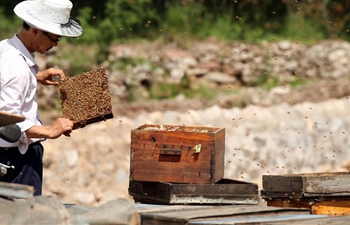CHICAGO, June 11 (Xinhua) -- A study shows that shifting day length alone was enough to trigger the cascade of signals that prepare the hamster for winter, regardless of temperature or how much food is available.
The Siberian hamster is a model organism for studying seasonal biological rhythms. They breed during the spring and early summer, but as fall approaches, their bodies change dramatically. The hamsters lose almost half their body weight, mostly through fat, and limit food intake by 30 percent to 40 percent. Their fur thickens and changes color to stark white, and they become infertile until they begin reversing course to prepare for the next breeding season.
The researchers including those from the University of Chicago (UChicago) focused on activity in the hypothalamus, part of the brain that initiates a number of important metabolic processes like releasing hormones, providing signals to the thyroid, and controlling body temperature, hunger and sleep.
They interpreted the data about how genes were expressed, looking for differences between samples taken from hamsters during the summer and winter periods.
The researchers narrowed in on a gene called pomc.
That chain of events begins with thyroid hormone, which is called T4. The T4 hormone is readily available in the bloodstream, and when the amount of daylight begins to increase in the spring, the hamster produces enzymes called deiodinases. These enzymes remove an iodine molecule from T4 and turn it into a more potent hormone called T3 that controls the activity of pomc.
During the summer, increased T3 production allows the hamsters to become fertile, and also ramps up pomc activity, causing them to gain weight. As the days shorten in the fall, T3 production decreases, shutting down reproduction for the upcoming winter. Lowered T3 also switches off pomc, resulting in dramatic weight loss.
The researchers also compared the genome of the Siberian hamster to other small mammals like mice and voles, and noticed a lot of differences between animals in the sequence patterns, or motifs, in the promoter region of the pomc gene.
The Siberian hamster shares the same motif with other seasonal breeders, suggesting that it's key to how pomc is expressed to manage the summer-winter adaptations.
"All animals show a level of seasonal biology, humans included. What our findings show, in hamsters, is that thyroid hormones acting in the brain where pomc is expressed provides the long-term regulation of energy balance," said senior author Tyler Stevenson, a former postdoctoral fellow at UChicago and now on the faculty at the University of Glasgow.
"What is completely fascinating is that this process evolved in some animals, like hamsters and voles, and not in others, like sheep or humans. This tells us that a large degree of genome variability exists across animals and indicates a strong species-specific control of long-term energy balance," Stevenson said.
In a separate set of experiments, the researchers also restricted the amount of food for the hamsters. While this caused some changes in brain chemistry, it didn't have an effect on pomc expression. Only long-term changes to day length had an effect on pomc.
"Researchers who study obesity should pay attention to this model because this is an animal that becomes reversibly obese. Then it can lose almost half its body weight on cue when the day length says it's time to lose weight," said Brian Prendergast, a professor of psychology at UChicago and one of the authors of the study. "They're a wonderful puzzle for understanding all of these processes."
The study has been published this week in the Proceedings of the National Academy of Sciences.













